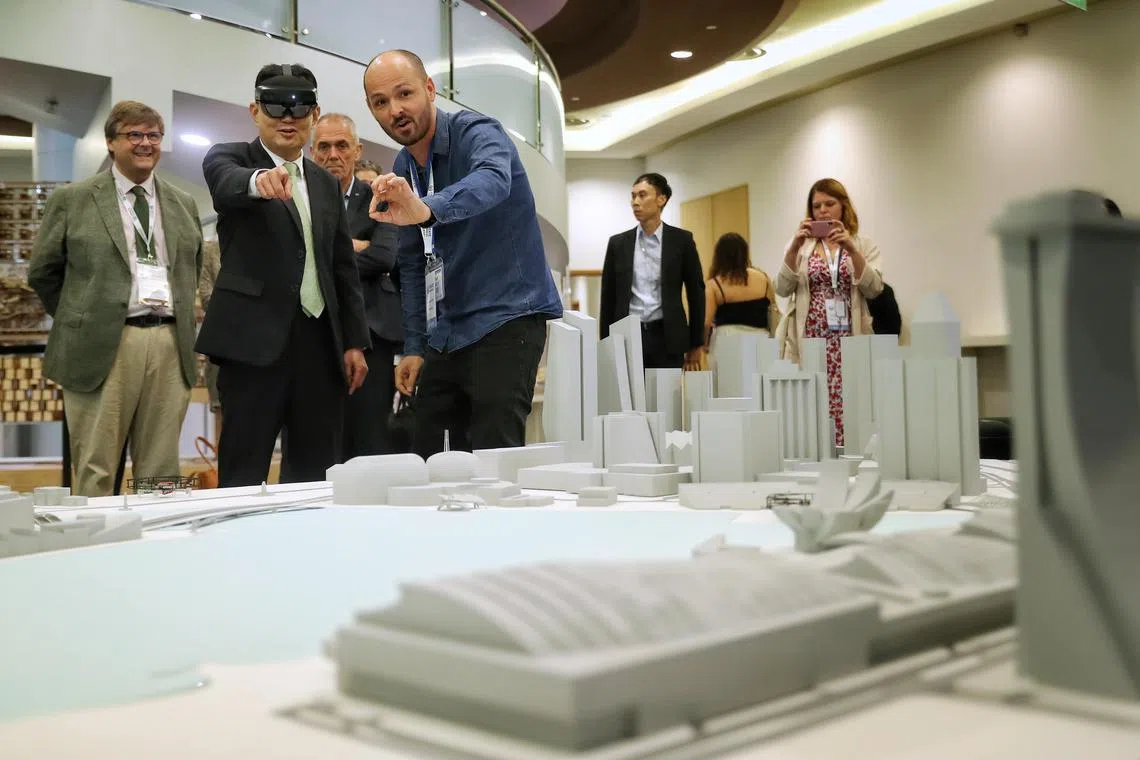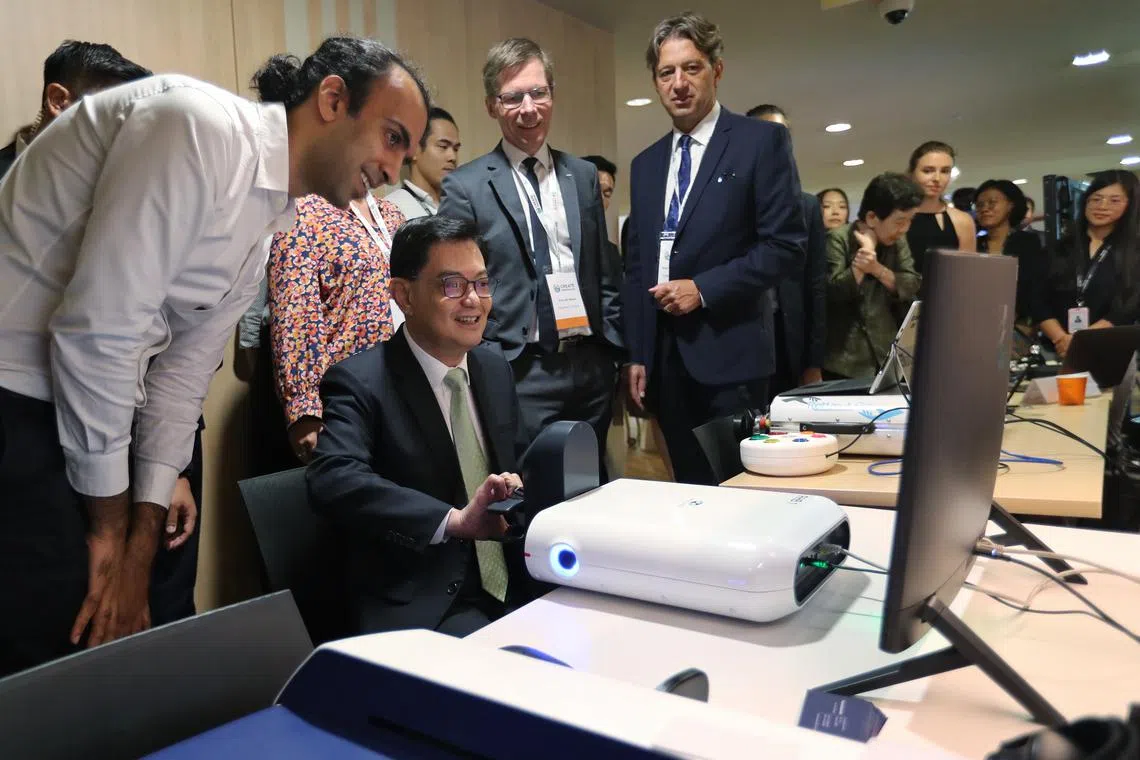New programme aims to make lab-grown meat safe from contamination
Sign up now: Get ST's newsletters delivered to your inbox

Deputy Prime Minister Heng Swee Keat trying the augmented reality goggles which show the behaviour of wind in the city, at the Create Symposium 2023, where he also delivered a speech.
ST PHOTO: GIN TAY
Follow topic:
SINGAPORE – With the business of cultured or lab-grown meat set to take off here, a new initiative aims to make sure such alternative protein sources are safe for consumption.
The Bioengineering Tools for Next-Generation Cellular Agriculture (CellAg) programme plans to develop sensors for the early detection of microbial contamination during the production of cell-based foods, as well as to develop compounds that can prevent such contamination without antibiotics.
“If successful, these can increase the yield and quality of alternative foods, while reducing costs,” Deputy Prime Minister Heng Swee Keat said on Monday, when the initiative was unveiled at the Create Symposium, themed Science Of Sustainable Cities.
CellAg – a collaboration between the Hebrew University of Jerusalem (HUJ) and Nanyang Technological University (NTU), among other research institutions – is funded by the National Research Foundation (NRF) through its international Campus for Research Excellence and Technological Enterprise (Create).
Mr Heng, who is also NRF chairman, said the programme is an example of Create’s focus on developments for sustainable cities in recent years.
“By the end of this century, urbanisation will see most of the world’s population living in cities. I hope that what is tested in Singapore may also be relevant to the world,” he said during the event, held at University Town on the National University of Singapore’s campus.
Professor Shlomo Sasson, the chief executive of the Singapore-HUJ Alliance for Research and Enterprise, which is spearheading CellAg, said the project aims to have a proof of concept at the end of an initial 3½-year phase. After that, it will be adapted to the needs of the cultured meat sector.
“This is going to become a very important industry for food security in Singapore, and this project actually is going to support it,” said Prof Sasson.
Investments in cultivated meat firms in the Asia-Pacific grew by 96 per cent, from $48 million in 2021 to $95 million in 2022, according to think-tank Good Food Institute APAC.
Local firm Esco Aster has said it will set up an 80,000 sq ft plant in Changi by 2025 to produce at least 400 to 500 tonnes of cell-cultured meat a year.
The Straits Times reported in March
A report by the Food and Agriculture Organisation and the World Health Organisation earlier in 2023 identified antibiotic traces and pathogens in animal cells as potential hazards of cell-based meats, though it acknowledged these risks exist in conventionally produced foods as well.
At the symposium, Mr Heng also announced the Mens, Manus and Machina programme, which aims to make technologies such as artificial intelligence and machine learning more efficient, as well as to ensure that people learn how to use the new technologies as their adoption increases.

Deputy Prime Minister Heng Swee Keat trying ReHandyBot during his tour at the Create Symposium 2023.
ST PHOTO: GIN TAY
The initiative will bring together both computer science and social sciences experts, said its lead principal investigator, Professor Zhao Jinhua, from the Massachusetts Institute of Technology, which will work with researchers from the Singapore Management University.
The CellAg and Mens, Manus and Machina programmes will each receive funding of between $5 million and $25 million from NRF, depending on the scale of the project.
In his speech, Mr Heng noted that Create now had established partnerships with nine institutions around the world, including the University of Cambridge and the Technical University of Munich.
He called on Create to shift from collaborating with only a small number of partners to working with multiple institutions to tackle common challenges.
This would allow it to do ground-breaking work that no one country or institution can tackle on its own, he said.
Mr Heng said Create must also become an integral part of Singapore’s start-up ecosystem, as part of its efforts to translate research into real-life solutions.
“Our venture capital market is lively, with 651 deals valued at nearly $11 billion recorded in 2022,” he said.
This would allow Singapore to become a node of technology, innovation and enterprise, working with other such regions to introduce solutions for Asia and the world.
“So even as Create deepens its capabilities to drive bold and game-changing research, I hope that you will also consciously think about and tap on the broader ecosystem that Singapore offers, to raise the impact of your good work,” he said.
Formed in 2007, Create has filed 903 patent applications and 542 invention disclosures, and started 31 spin-off companies.
Fostering collaborative R&D
Here are some projects that local and foreign universities are collaborating on at the National Research Foundation’s Campus for Research Excellence and Technological Enterprise (Create).
Thrixen
Researchers are developing a low-cost test for clinics to help doctors determine whether a patient’s ailment is bacterial or viral. This will prevent unnecessary prescription of antibiotics, which only treat bacterial infections, and minimise future antibiotic resistance.
Antimicrobial resistance is a growing problem, as the overuse or misuse of antimicrobial drugs accelerates the evolution of bacteria and viruses immune to existing treatments.
DesCartes
This project hopes to create intelligent modelling systems for infrastructure management and urban planning such as traffic management, by combining existing data and artificial intelligence. This includes flying drones throughout the city to model the environment based on factors like wind speed and direction, or air pollution.
Cambridge Centre for Advanced Research and Education in Singapore (Cares)
Cares works directly with the Government to ensure a safe decarbonisation of Singapore’s maritime industry. Among its projects are thermal dynamic models to measure the emissions of future ships based on factors such as energy costs, fuel type, or carbon emissions.
Researchers are also trialling the use of drones to monitor fuel leakage rates, such as of methanol, into the ocean to improve management of pollution from ships.
The Calipso Project
Researchers are developing a 3D imaging microscope to help hospitals create personalised medicines or drug screenings for patients. The microscope enables the 3D reconstruction of the cellular organisation and quantitative measurement organoids, which are three-dimensional lab cultures composed of the different cell types in a particular organ. It mimics the function and biology of the organ, for example, in reaction to drug treatment. The Calipso system can image organoids, which are half to twice the thickness of a hair, 50 to 200 times faster than current commercial approaches.

